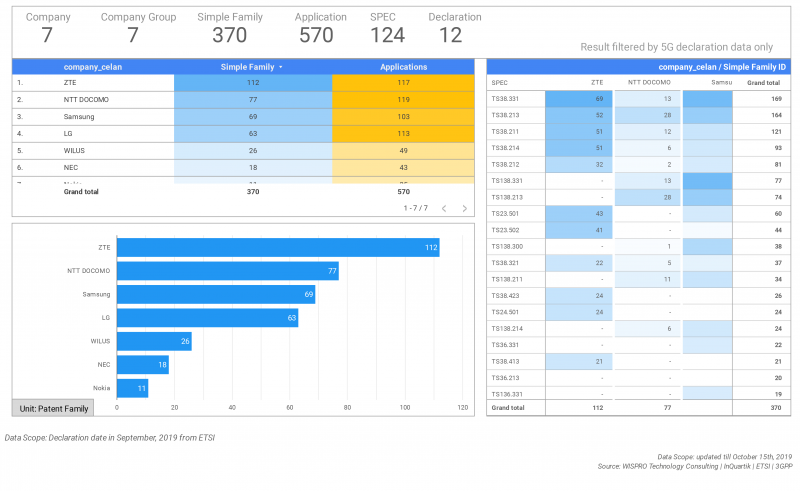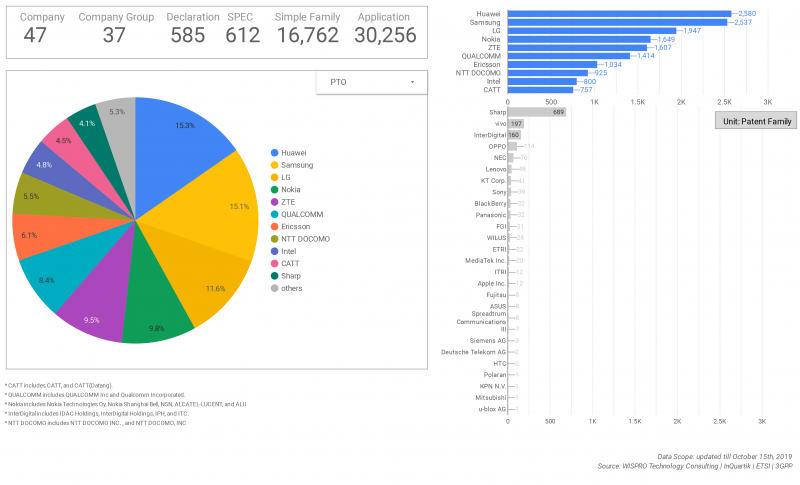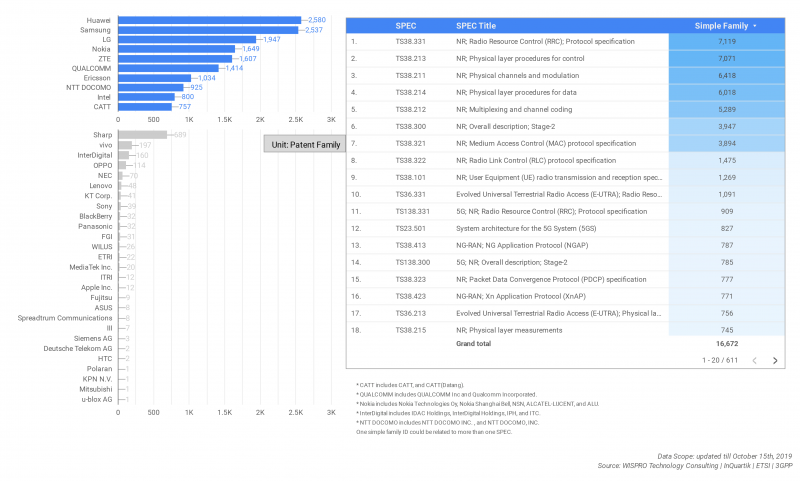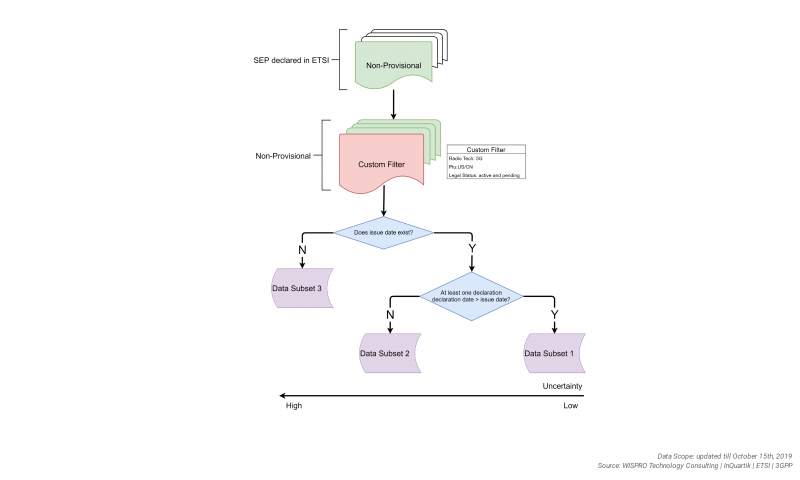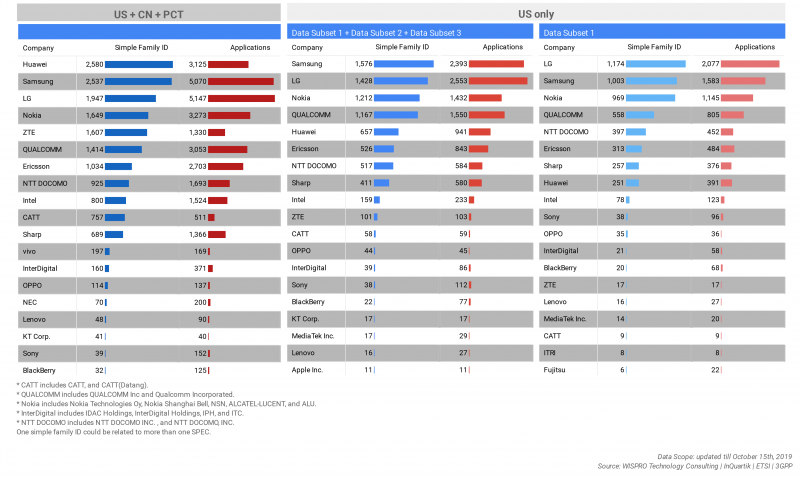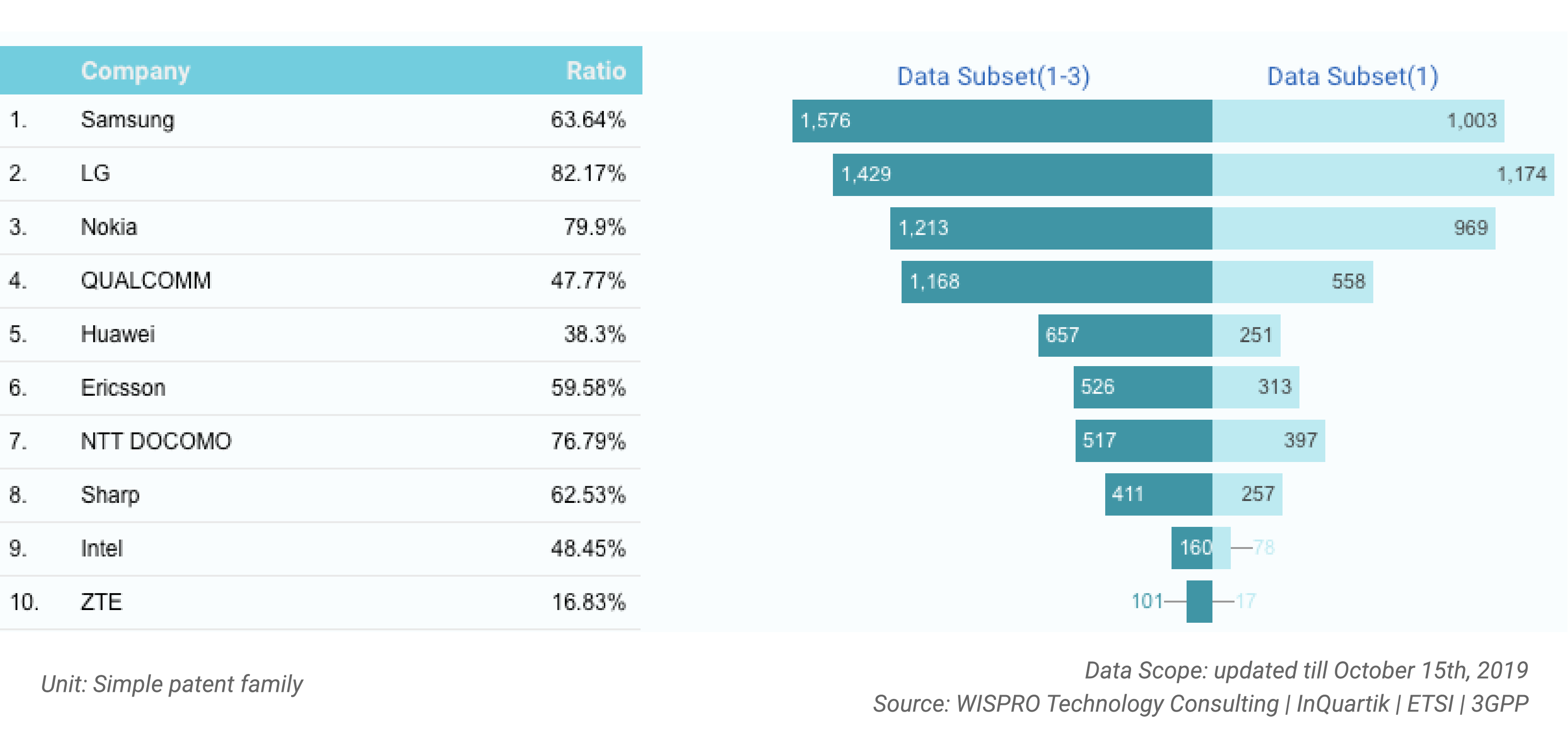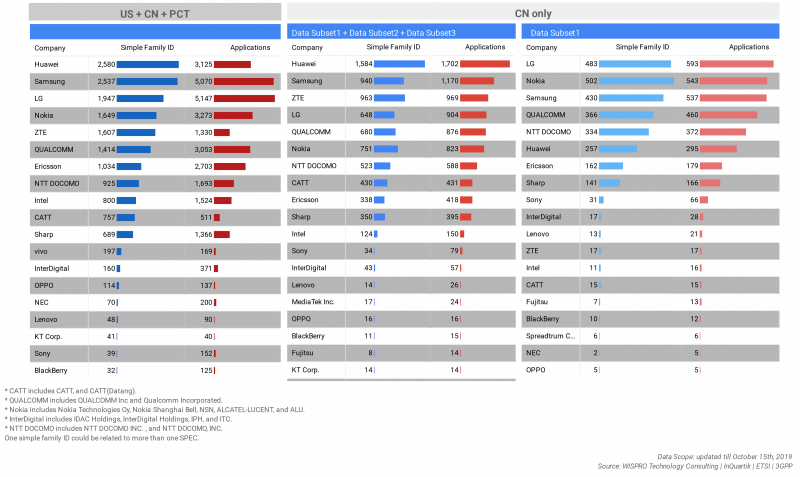“Not all Standard Essential Patents (SEPs) are actually essential – a phenomenon called over-declaration.”[1]
Over-declaration is like a fog that can mislead the public and keep it from seeing the actual truth, e.g., (1) which declared SEPs are actually true SEPs; (2) how many true SEPs exist; and (3) who has declared these true SEPs and who currently owns them. While declaration information is often ambiguous, it can also be difficult to recognize whether the royalty rate of an SEP license is under FRAND terms or not. In other words, over-declaration has prompted questions to be raised about patent quantity and patent quality. Even though several articles (e.g., [2], [3], [4], and [5]) have already addressed this situation and tried to propose solutions to these problems, over-declaration continues to be something that still exists today.
In this article, we would like not only to share a monthly snapshot of declared 5G SEPs, but also to share our working assumptions in order to mine more reliable information in a simpler way, along with some of our findings from the over-declaration of SEP data.
The data retrieved for this report is for US, WO, and CN patent applications (excluding US provisional patent applications) declared to ETSI in September 2019.
5G ETSI Declaration Activity: September 2019
The above charts indicate that ZTE, NTT DOCOMO, Samsung, LG, and WILUS (WILUS INSTITUTE OF STANDARDS AND TECHNOLOGY INC.) are the Top 5 declarants of 5G SEPs for September 2019. It’s also worth mentioning that WILUS made its first 5G SEP declaration during this period.
The dashboard also details the number of declared patent families for each Technical Specification. The Top 3 for September 2019 are as follows:
- TS38.331 (Radio Resource Control);
- TS38.213 (Physical Layer Procedures for Control);
- TS38.211 (NR; Physical channels and modulation).
5G SEP Declaration Activity: The September 2019 Rankings
Overview

Technology standard vs Declared SEPs
Now, let’s take a look at the accumulated rankings. Immediately, it becomes clear that Huawei is once again at the top of the list for the number of declared SEPs, which has been true for four consecutive months. Samsung, LG, Nokia, and ZTE complete the Top 5.
Furthermore, if we take only the quantity of declared 5G SEP families into consideration, the benchmark for entering the Top 10 is still 757 patent families (which were declared by CATT.)
So far, in our series of articles, the observations about the declared data from the ETSI database has been based on facts (the data itself) instead of predictions. Although the statistical data above already eliminates a minor part of the over-declaration phenomenon by excluding the declared US provisional patent applications, we believe that the reliability of the statistics could be improved by taking into consideration other data characteristics.
Here is what we observed and what we did.
Over-declaration means declaration data containing an unknown amount of uncertainty
In regards to the over-declaration phenomenon, the ETSI IPR Policy itself might provide an answer as to why over-declaration continues to occur.
The term “might be” implies that each declared SEP contains some amount of uncertainty in order to prove that it is a true SEP, and such uncertainty results in over-declaration. Specifically, as we mentioned in the previous article, in order to be deemed a quality SEP, an SEP must possess at least two key characteristics: essentiality and patentability. That is to say, the current declaration data comprises at least 2 kinds of uncertainties in nature, which are (1) uncertainty of essentiality and (2) uncertainty of patentability, both of which are dynamic and might change over time.
Let’s take a closer look at the uncertainties by referring to the following figure.
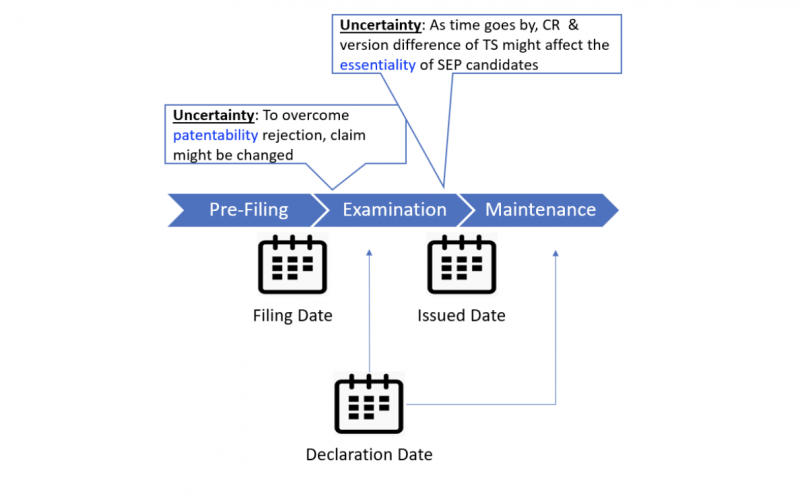
As described in the ETSI IPR Policy, essentiality is a must in order to make or operate equipment or a method which complies with the standard.
Why is essentiality one kind of uncertainty? Because the patent scope is limited by what embodiments are contained in a patent application at the filing date, and during the development of the standard, either the technical contribution (e.g., TDocs, including change request “CR”) or version differences of the technical specification (“TS”) might affect the essentiality of the declared SEP candidates.
(2)Patentability:
On the other hand, to own a SEP, a patent applicant has to file at least a patent application with the original claim set, which relates to certain standards in the future relative to the filing date (more precisely, the priority date), and to get the patent application with the allowed claim set to be issued (having an issued date). While overcoming patentability challenges from the examiner’s office actions, the claim scope might be changed accordingly. This is another uncertainty for SEPs, because, from the public’s viewpoint, it’s difficult to track declared SEP data about whether the changed claim scope could be still essential to certain standards.
To comply with the ETSI IPR Policy, a declarant has to submit a declaration comprising at least one patent, which might be essential, no matter whether the patent is either a pending patent application or an issued patent. By making this declaration, the patent will be given a declaration date. Obviously, by having a better understanding of the uncertainty described above, it’s easier to see why over-declaration confuses the public.
Working assumptions
In contrast to domain experts who determine the essentiality of each declared patent by reviewing the claim charts, is it possible to find a simple alternative solution to obtain more convincing information from the over-declaration data? Based on this objective and an observation of the uncertainty data, we have proposed the following working assumptions by using the data features of the declared patents, to lower the uncertainty of over-declaration for getting more reliable information.
The diagram above shows our working assumptions and the logic behind the classification decisions.
Here it is, in detail:
1.Assume all the declared SEPs, on their declaration dates, have the same level of essentiality without prejudice or discrimination.
2.Step 1: Exclude US provisional patent applications, since they generally have less chance of becoming SEPs when compared to non-provisional patent applications;
3.Step 2: Filter declared patents by the following conditions:
- Country: US and CN separately. We don’t select PCT (WO) patent applications because WO patents don’t have any data about the issued date.
- Legal status is either active or pending. In other words, we exclude the inactive declared patents (e.g., abandoned, withdrawn, revoked, and expired)
4.Step 3: Separate the remaining declaration data into 3 groups based on different uncertainty standards (from the lowest to the highest relatively).
- Data Subset 1: Patents having declaration dates later than their issued date. This data feature reflects the fact that patent owners declared patents to ETSI after the patents were issued. The reason for this data subset having the relative lowest uncertainty is that the claim passed the patentability challenge by the examiners of each patent office, and this is something that won’t change, unless someone successfully challenges the patentability.
- Data Subset 2: Patents having declaration dates earlier than their issued dates. This is slightly different than data subset 1, because such patents were declared to ETSI before they were issued. It should be noted that data subset 2 has more uncertainty than data subset 1 because the claim scope might have changed in order to get the patent issued, and such changes affect the uncertainty of essentiality if the patent owners decide not to re-declare the issued patents (if the patent owner re-declares the issued patents, then the patents will go to data subset 1).
- Data Subset 3: Patents having no issued date yet. That is to say, declared patents within data subset 3 are patent applications under examination phase that still have both uncertainty of essentiality and uncertainty of patentability.
Insights
Because the uncertainty varies among data subset 1, data subset 2, and data subset 3, we decided to separate them in order to observe what the difference is against putting them together.
Declaration of 5G US SEPs
As shown in the following figure, we listed 3 tables with different data scopes side-by-side for simultaneous comparison. The table on the left covers declared US/CN/PCT patents; the table in the center covers a combination of data subsets 1 to 3 (US patents only) as defined above; and the table on the right covers data subset 1.
Via comparing the left-sided table and central table, it reveals some changes in position for some companies, e.g. both Huawei and ZTE decreases the overall quantity of the declared patents and corresponding ranking in the central table. By contrast, the other leading companies in the left table remains similar ranking position in the central table. The data in these 2 tables reflects SEP owners have different strategies and invested resources for their SEP portfolio deployment on countries.
Furthermore, in a scenario about the SEP license negotiation, it’s obviously helpful to seek consensus on the FRAND royalty rate if the SEP data is transparent enough and is eliminated uncertainty as much as possible. Specifically, the ranking information revealed within the right-sided table is more reliable and more precise than the other 2 tables, because the right-sided table covers only the declared patents which having the lowest uncertainty based on our working assumption in this article. Even though, it should be carefully noted that the information retrieved from the data could be a quick reference instead of replacing due diligence in detail by domain experts.
In addition, by observing the ratio of patent families in the data subset 1 over the data subsets 1-3 (in this article, we only take the top 10 companies based on declared US SEP families as an example), the statistics reveals which companies intend to declare their SEP portfolio with less uncertainty or more uncertainty. In fact, it’s not a problem either correct or wrong, but a decision based on what patents the companies owned and on the timing, because the ETSI IPR Policy does not limit the legal status of “any patent”. In summary, the data reflects fact for several interpretations, e.g.
- The companies’ intention to declare patents with different uncertainties;
- Current status about composition of the declared patent portfolio of each company, e.g. pending patents vs. issued patents.
Declaration of 5G CN SEPs
Similarly, by observing the declaration data of 5G CN SEPs in the following table, it becomes evident that companies from Korea, Europe, the United States, and Japan own more issued patents than other companies. At the same time, it also becomes clear that Chinese companies, e.g., Huawei, ZTE, and CATT, have been competing aggressively in the 5G race, since they have declared a huge number of pending patents, even though the number of issued patents declared is smaller.
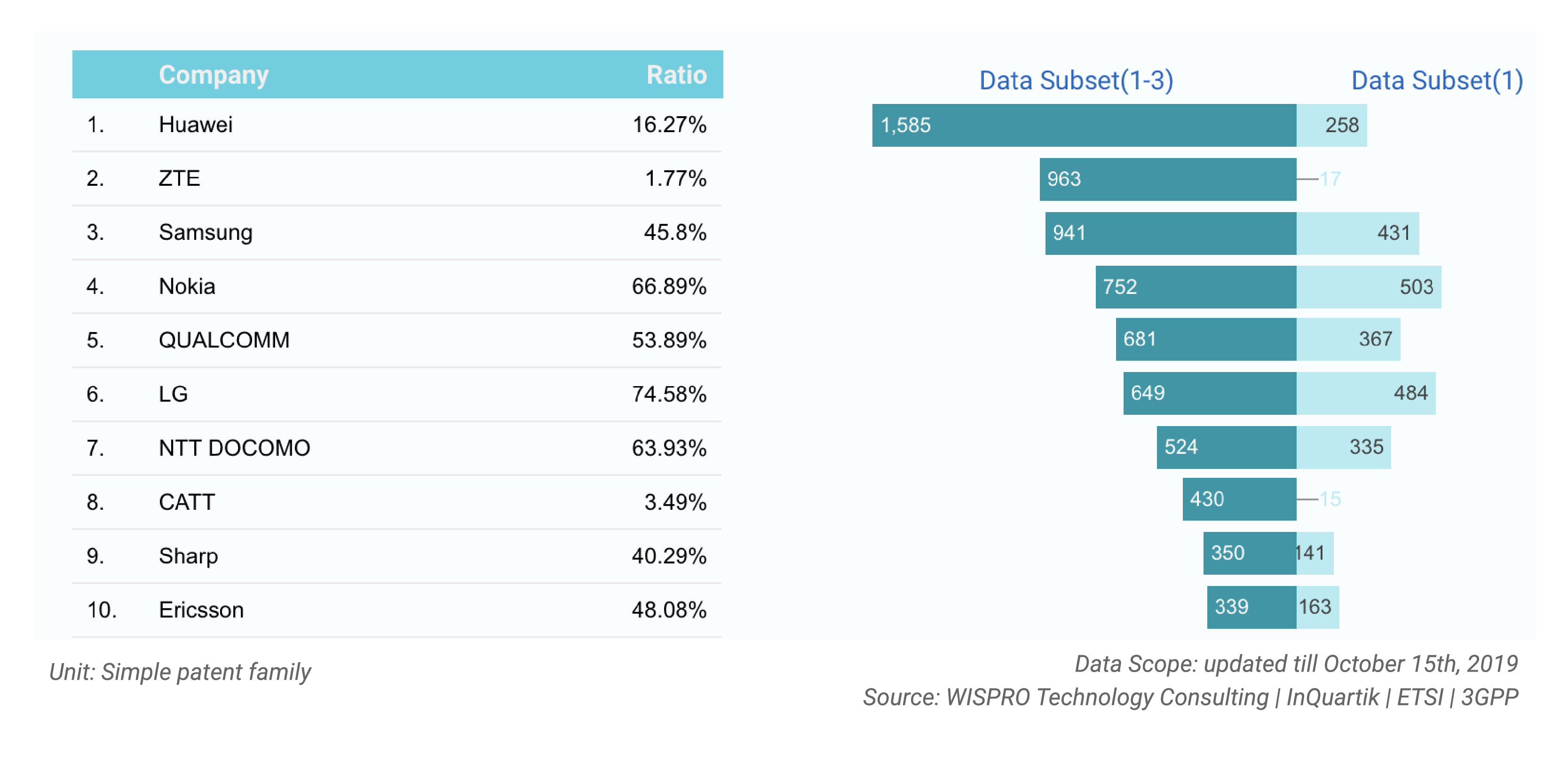
Conclusion
For stakeholders in the SEP eco-system, e.g., SEP owners, SEP investors, or SEP implementers, the information derived from this SEP declaration data can be a critical factor in various business decisions.
For example, with this information, an SEP owner can gain a better understanding of the industry position and/or the performance of the collaboration between R&D and IP, as well find support for the selection of R&D topics and allocation of resources. As for SEP investors, they can use this information to know who owns what SEPs, which can be important for their investment evaluation. And SEP implementers can accelerate the time-to-market of commercialization based on SEP licenses and estimate FRAND royalty more precisely.
It’s a pity that the over-declaration phenomenon still exists in the ETSI database so that the ranking information only considering quantity might not be practical and convincing enough for supporting various business decisions. Therefore, we propose simple working assumptions to eliminating some uncertainty from the over-declaration phenomenon to get more reliable information. From a data perspective, it’s a start but definitely not the end, and we will continue to research SEP data in order to find more meaningful and useful information.
To keep up-to-date on the latest 5G SEP news, trends, insights, and reports, please visit our website here.
Reference
[1] Stitzing, Robin and Sääskilahti, Pekka and Royer, Jimmy and Van Audenrode, Marc, Over-Declaration of Standard Essential Patents and Determinants of Essentiality (October 27, 2017). Available at SSRN: https://ssrn.com/abstract=2951617 or http://dx.doi.org/10.2139/ssrn.2951617
[2] Cambridge Handbook of Technical Standardization Law – Antitrust, Competition and Patent Law ( Jorge L. Contreras, ed., 2017 Forthcoming)
[3] Wilson, Kelce, Designing a Standard Essential Patent (SEP) Program (July 12, 2018). les Nouvelles – Journal of the Licensing Executives Society, Volume LIII No. 3, September 2018. Available at SSRN: https://ssrn.com/abstract=3212735
[4] Matthew Noble, Jane Mutimear and Richard Vary, Determining which companies are leading the 5G race, IAM Issue 96, published by Globe Business Media Group
[5] Joff Wild, Patent quality, not quantity, is what really counts when it comes to standards essentiality, IAM (May 6, 2019)
Data disclaimer: We have used commercially reasonable efforts to ensure that the data provided is complete and has been obtained from reliable sources. The information contained in this report is current as of the date of this report and may not reflect any circumstances that occur after such date. This report is not intended as legal advice. All information is provided “as-is” and we make no representation or warranty of any kind. We will not be liable for any lost profits, revenues, indirect, special consequential, exemplary or punitive damages resulting from this report.

